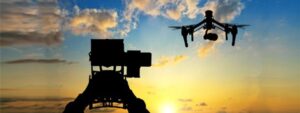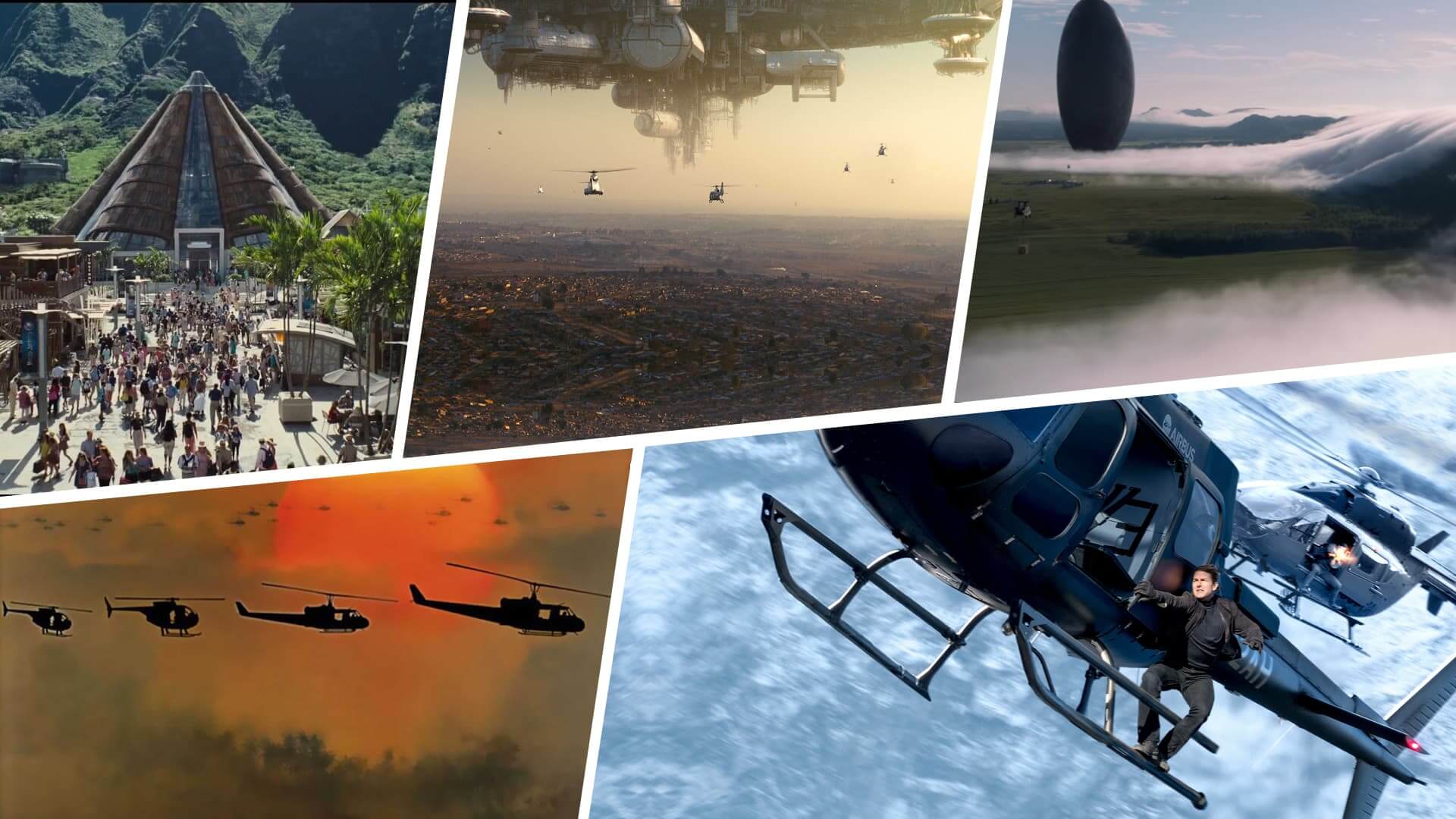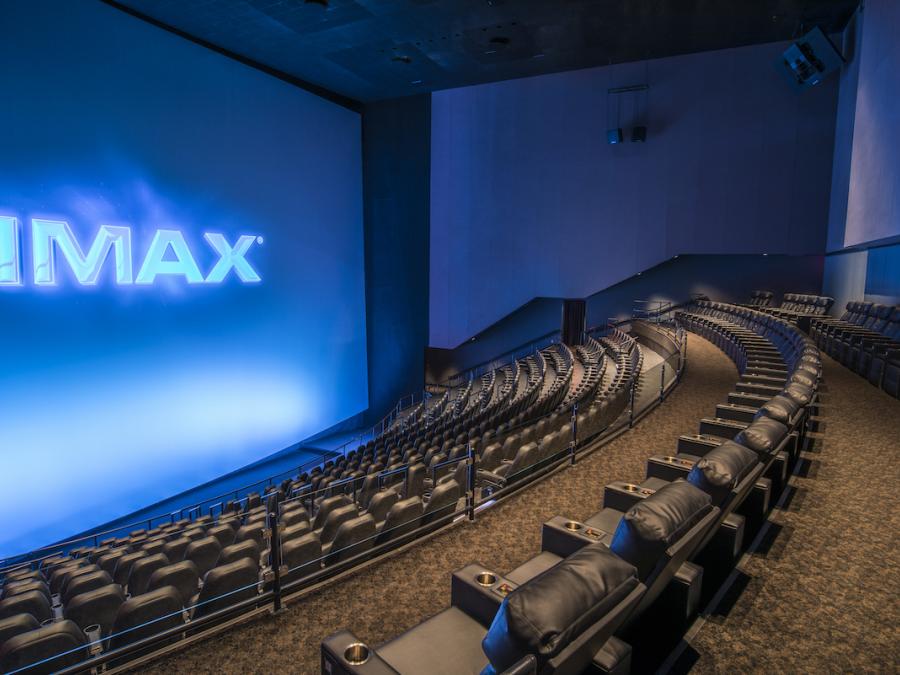Aerial cinematography has undergone a remarkable transformation in recent years, thanks to the integration of drones into filmmaking practices. With their ability to capture stunning footage from unique perspectives, drones have redefined the art of cinematography, offering filmmakers unprecedented creative possibilities. From sweeping aerial vistas to dynamic tracking shots, drones have opened up new avenues for storytelling and visual expression in the world of cinema. In this article, we’ll explore the impact of drones on aerial cinematography and examine how they have revolutionized the way filmmakers approach capturing stunning visuals from the sky.
Drones have democratized aerial cinematography, making it more accessible and affordable than ever before. In the past, capturing aerial footage required expensive equipment such as helicopters or cranes, limiting its availability to large-scale productions with substantial budgets. However, drones have leveled the playing field, allowing filmmakers of all backgrounds to incorporate aerial shots into their projects. Whether shooting a low-budget indie film or a commercial advertisement, filmmakers can now harness the power of drones to elevate their storytelling and create visually captivating scenes without breaking the bank.
Furthermore, drones offer unparalleled flexibility and maneuverability, enabling filmmakers to capture shots that were once considered impossible or impractical. With their compact size and agile flight capabilities, drones can navigate tight spaces and capture footage from virtually any angle, providing filmmakers with unprecedented creative freedom. From soaring through narrow alleyways to gliding over vast landscapes, drones empower filmmakers to push the boundaries of traditional cinematography and explore new artistic horizons. As a result, aerial cinematography has evolved from a niche technique to an essential tool in the filmmaker’s arsenal, enriching storytelling and enhancing the viewer’s cinematic experience.
The Rise of Drone Technology

The rapid advancement of drone technology has played a pivotal role in shaping the evolution of aerial cinematography. In recent years, drones have become more sophisticated, boasting advanced features such as high-resolution cameras, stabilized gimbals, and intelligent flight modes. These technological innovations have elevated the quality of aerial footage, allowing filmmakers to capture breathtaking visuals with unparalleled clarity and precision. With the ability to shoot in ultra-high definition resolutions such as 4K and even 8K, drones enable filmmakers to produce cinematic imagery that rivals traditional camera setups.
Moreover, drones have become increasingly user-friendly, thanks to intuitive controls and automated functions that streamline the filmmaking process. Modern drones are equipped with intelligent flight modes such as waypoint navigation, orbit mode, and follow-me tracking, allowing filmmakers to execute complex shots with ease. Whether filming a dramatic chase sequence or a scenic landscape montage, filmmakers can rely on drones to deliver smooth, professional-grade footage without requiring extensive piloting skills. As a result, drones have become indispensable tools for filmmakers seeking to capture dynamic aerial shots with minimal hassle and maximum efficiency. The perspective they show has proven to be very useful for environmental protection campaigns that use these videos to highlight the various problems the planet is dealing with today, so when you do some big jobs and you’re left with a lot of garbage that you don’t know how to deal with, rely on to the junk removal in Philadelphia PA that will take care of it.
In addition to their technical capabilities, drones have also revolutionized the way filmmakers approach storytelling and visual composition. By offering new perspectives and vantage points, drones enable filmmakers to craft immersive narratives that engage and captivate audiences. Whether used to establish the scale of a sprawling cityscape or to highlight the intimacy of a character’s emotional journey, aerial shots can evoke powerful emotions and enhance the overall impact of a film. As filmmakers continue to push the boundaries of creativity and innovation, drones will undoubtedly play an integral role in shaping the future of aerial cinematography. In order for all of this to look perfect from every angle, the actors use increasingly popular Korean skincare to make their faces look great in every shot, both on film and at various events they attend.
Challenges and Considerations
While drones have undoubtedly revolutionized aerial cinematography, their widespread adoption has also raised a host of challenges and considerations for filmmakers. One of the primary concerns is safety, as drones pose potential risks to both crew members and bystanders if not operated responsibly. To mitigate these risks, filmmakers must adhere to strict safety protocols and regulations governing drone operations, including obtaining necessary permits and certifications, conducting thorough risk assessments, and implementing emergency procedures. So, in the end, this still represents a job with a lot of stress and responsibility, and in order to cope with this, the members of the estate often undergo excellent recovery wear that remove the accumulated stress and pain in the body.
Furthermore, drones present logistical challenges related to battery life, flight range, and weather conditions, which can impact the feasibility and execution of aerial shots. Filmmakers must carefully plan and coordinate drone flights to ensure optimal conditions for capturing footage while minimizing disruptions and safety hazards. Additionally, drones require regular maintenance and calibration to ensure optimal performance, adding to the logistical complexity of incorporating aerial cinematography into film productions. While using them, filmmakers often use useful ring cases that are very travel-friendly to protect their valuable jewelry while shooting different shots.
Another consideration is the potential impact of drones on traditional filmmaking practices and industry dynamics. While drones offer unprecedented creative opportunities, some filmmakers may resist their adoption due to concerns about job displacement, creative autonomy, and aesthetic integrity. As drones become more ubiquitous in filmmaking, industry professionals must adapt to new technological paradigms and explore innovative approaches to storytelling that leverage the unique capabilities of aerial cinematography while preserving the artistry and craftsmanship of traditional filmmaking techniques. By embracing drones as tools for creative expression rather than mere gadgets, filmmakers can harness their transformative potential to elevate the art of cinematography and inspire audiences worldwide. Such opportunities and ideas are indispensable topics of various world seminars that are very popular, especially in Europe, and if you go to one of them, don’t forget to take advantage of the benefits of e-sim in order to stay in touch with loved ones at home in the easiest way.
Exploring New Frontiers

As filmmakers continue to explore the possibilities of aerial cinematography, new frontiers are emerging that push the boundaries of traditional filmmaking even further. One such frontier is the integration of artificial intelligence (AI) and machine learning algorithms into drone technology, opening up exciting possibilities for autonomous filmmaking. By harnessing AI-driven drones, filmmakers can delegate repetitive tasks such as flight planning, camera control, and shot composition to intelligent algorithms, freeing up creative resources to focus on storytelling and artistic vision. This paradigm shift in filmmaking not only enhances efficiency and productivity but also fosters collaboration between human creativity and machine intelligence, leading to groundbreaking innovations in visual storytelling. The new perspectives that this introduces to the film imply a significant effort on the part of the actors, costume designers, and make-up artists so that everything on such a camera remains perfect as it was intended, due to such constant changes and long shoots in order to maintain the beauty of their skin and face, many go for advice by world-renowned dermatologist Cheyanne Mallas.
AI-Driven Filmmaking
AI-driven filmmaking holds the potential to revolutionize the way films are produced, enabling filmmakers to achieve unprecedented levels of precision, consistency, and creativity in their work. By analyzing vast amounts of visual data and learning from established cinematic conventions and techniques, AI algorithms can generate dynamic shot compositions, anticipate narrative beats, and adapt to changing environmental conditions in real-time. This collaborative approach to filmmaking empowers filmmakers to explore new storytelling techniques and experiment with unconventional narrative structures, pushing the boundaries of cinematic artistry and audience engagement. Music plays an exceptional and significant role in all of this, as technology has advanced, and some famous works from famous film productions are still popular today, so if you have them, you can sell vinyl records for cash and make easy money.
Moreover, AI-driven drones can enhance the safety and reliability of aerial cinematography by autonomously navigating complex environments, avoiding obstacles, and optimizing flight paths to capture the perfect shot. With built-in safety features and real-time monitoring capabilities, AI-driven drones offer filmmakers peace of mind and confidence in their ability to execute ambitious aerial sequences with precision and finesse. As AI technology continues to evolve and mature, the possibilities for autonomous filmmaking are virtually limitless, paving the way for a new era of creativity and innovation in the world of cinema. In this way, it is possible for the creators to take a break from time to time and with a small break, catch an excellent appointment to relax in a luxury spa in Toronto.
Virtual Production and Mixed Reality
Another frontier in aerial cinematography is the integration of virtual production techniques and mixed reality technologies into drone filmmaking workflows. By combining live-action footage with computer-generated imagery (CGI) and virtual environments in real-time, filmmakers can create immersive cinematic experiences that blur the line between fantasy and reality. With the advent of advanced motion capture systems and real-time rendering engines, filmmakers can seamlessly integrate live-action performers with digital assets and virtual sets, allowing for unprecedented creative freedom and visual fidelity in aerial cinematography. All of this can be studied in more detail in excellent filmmaking courses.
Virtual production techniques also offer practical benefits for filmmakers, such as cost savings, time efficiency, and creative flexibility. By eliminating the need for physical sets, props, and locations, virtual production enables filmmakers to create elaborate and fantastical worlds that would be impractical or impossible to achieve using traditional production methods. Moreover, the ability to visualize and iterate on creative ideas in real-time empowers filmmakers to make informed decisions on set, streamline the post-production process, and deliver high-quality results on time and within budget. If you want high-quality visual results within your budget related to the interior of your home, you can contact the excellent interior design studio Lighthouse Point.
The Future of Aerial Cinematography

As we look to the future of aerial cinematography, one thing is clear: the possibilities are limitless. From AI-driven drones to virtual production techniques, filmmakers have an unprecedented array of tools and technologies at their disposal to push the boundaries of visual storytelling and create unforgettable cinematic experiences. By embracing innovation, collaboration, and experimentation, filmmakers can harness the transformative power of aerial cinematography to inspire audiences, provoke thought, and evoke emotion in ways that were once unimaginable. As technology continues to evolve and creativity knows no bounds, the future of aerial cinematography promises to be as breathtaking and exhilarating as the vistas captured from the sky. This is a significant step forward in historical films that, with excellent military apparel, want to show the war through this perspective, creating a deeper experience for the viewer.
Conclusion
As the landscape of aerial cinematography continues to evolve, several emerging trends are reshaping the way filmmakers approach capturing stunning visuals from the sky. One notable trend is the integration of artificial intelligence (AI) and machine learning algorithms into drone technology, enabling automated flight paths, intelligent tracking, and real-time image processing. By harnessing the power of AI, filmmakers can enhance their creative capabilities and streamline the filmmaking process, allowing for more efficient and dynamic aerial shots. Today, artificial intelligence is incorporated into many things to make our lives easier, and among other things, you can consider investing in some of the excellent houses in Boca Falls that, apart from being very livable, also offer excellent opportunities to install a smart home system that provides various benefits.
Another emerging trend is the use of virtual reality (VR) and augmented reality (AR) technologies to enhance the viewer’s immersive experience. Filmmakers are experimenting with VR drones equipped with 360-degree cameras to capture immersive aerial footage that transports viewers into the heart of the action. Additionally, AR overlays can enhance aerial shots with contextual information, interactive elements, and visual effects, creating a multi-dimensional viewing experience that blurs the line between reality and fantasy. An Internet provider that manages IT services in San Antonio provides its users with excellent Internet with which they can explore the boundaries of VR as they embark on a virtual exploration of museums or favorite movies, a whole new experience.
Furthermore, advances in drone design and propulsion technology are enabling filmmakers to push the boundaries of aerial cinematography even further. From foldable drones that can be easily transported to remote locations to hybrid drones capable of vertical takeoff and landing (VTOL) in tight spaces, filmmakers have access to an unprecedented array of tools and techniques for capturing dynamic aerial shots. Additionally, advancements in battery technology are extending flight times and increasing payload capacities, allowing filmmakers to capture longer sequences and use heavier camera equipment with ease. The advantages of longer and more usable battery power in drones have also found use with excellent church architects who use the convenience of cutting-edge technology to create designs for your desired cathedral.
In conclusion, the future of aerial cinematography is filled with exciting possibilities, driven by technological innovation, creative experimentation, and a passion for storytelling. As filmmakers continue to push the boundaries of what’s possible with drones, we can expect to see even more breathtaking aerial shots, immersive experiences, and innovative storytelling techniques. Whether capturing sweeping landscapes, epic action sequences, or intimate character moments, drones will undoubtedly play a central role in shaping the future of cinema, inspiring audiences and filmmakers alike to dream big and soar to new heights. So the only thing left for you to do is to curl up in your couch with warm natural tea and delicious milk chocolate edibles and enjoy some of the greatest film achievements.




